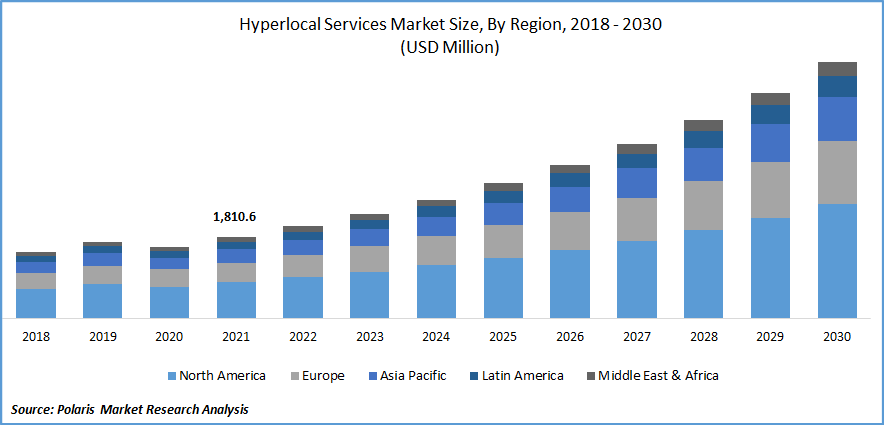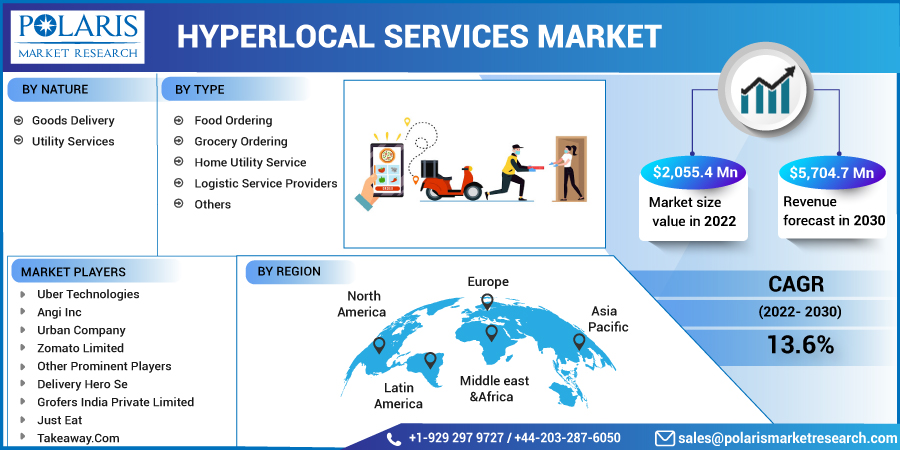
Hyperlocal Services Market Share, Size, Trends, Industry Analysis Report, By Nature (Goods Delivery, Utility Services); By Type; By Region; Segment Forecast, 2022-2030
- Published Date:Nov-2022
- Pages: 118
- Format: PDF
- Report ID: PM2871
- Base Year: 2021
- Historical Data: 2018-2020
Report Outlook
The global hyperlocal services market was valued at USD 1,810.6 million in 2021 and is expected to grow at a CAGR of 13.6% during the forecast period.
Hyperlocal commerce is the most widely recognized of the different hyperlocal activities. It has expanded dramatically over the past decade as India's online activity has increased. This tremendous growth is a gift from the previously established eCommerce sector. Grocery and food delivery services such as Instacart, Foodpanda, Delivery Hero, Swiggy, Grofers, and PepperTap are examples of Hyperlocal Commerce. Customers are connected to eateries and supermarket providers via smartphone platforms, and items are delivered via logistic networks.

Know more about this report: Request for sample pages
The hyperlocal service sector began to expand at the time of its introduction. eCommerce supplied a consistent consumer base and the acceptability required for the growth of various online services available in their area. The regular movement of customer care from the offline to the internet may establish consumers' trust in the items and transactions. Start-ups such as Doormint and UrbanClap offer everyday home services. Logistic support start-ups like Dunzo and Delhivery offer a distribution platform for necessities like pharmaceuticals, office equipment, and basic products like baggage, literature, etc. These logistics companies frequently use local individuals and their daily travels to convey the goods.
The hyperlocal paradigm does have certain limitations and issues. Local merchants who have never utilized the web find it challenging to comprehend the procedure and hope they are going to collaborate with the business correctly. This concept also has a significant distribution problem. Regional purchasers will not purchase stuff or use solutions if the cost of shipping is prohibitively expensive. As a result, the most significant difficulty for any organization is lowering the high transportation costs associated with providing the service. The quality of the product and service is the major problem associated with this method. If the performance does not meet the criteria, the buyer returns the items and will never use digital services again.
The COVID-19 epidemic and its influence on internet shopping orders are expected to cause a major decline in the size of the grocery delivery service business in emerging nations such as India and China in 2021. This calculation is based on the money earned by the meal transportation service. The effects of the lockdown have been proven to be positive for food and grocery delivery firms in various nations, including the United States.

Know more about this report: Request for sample pages
Industry Dynamics
Growth Drivers
Entrepreneurs are focusing their efforts on developing a foothold in the hyperlocal environment. Young entrepreneurs are concentrating on local locations, which leads to the broadening of their hyperlocal ecosystem. The hyperlocal business is still squabbling for territory in its surroundings to establish a stable platform for activities in the region. Furthermore, hyperlocal services multinational firms are improving search choices and technical support to provide an improved user experience. The emergence of better and more secure digital payment mechanisms has resulted in a considerable improvement in customer trust in the use of mobile platforms for operations. Through the projection period, these variables are likely to give good business growth possibilities.
Consumer spending for extraordinary services, particularly lightning-fast and smooth dispatch, has increased because of the epidemic. This has spurred technological innovation, particularly in the transportation and automobile industries. Powered by changes in customer and supplier needs, technology developments in mechanization, virtual reality, observations, accessibility, and AI are becoming critical. This increased pace and expansion have also made businesses more responsible and quicker as they fight to stay competitive and ahead of their competitors.
One of the most appealing arguments for adopting hyperlocal distribution is the cheap rate of capital. There is no practical requirement for storage facilities in this service paradigm. This significantly minimizes the upfront expenditure necessary to launch hyperlocal deliveries. Furthermore, unlike other distribution models, where clients have little knowledge of where their supplies are being obtained, hyperlocal deliveries make it a little simpler to win over clients. Other ways hyperlocal deliveries enhance user satisfaction include the opportunity to have a brief talk with a service executive and pass on details about consumer preference, as well as modify or add goods from the basket while the collection has officially begun.
Report Segmentation
The market is primarily segmented based on nature, type, and region.
|
By Nature |
By Type |
By Region |
|
|
|
Know more about this report: Request for sample pages
The Home Utility Segment Dominated the Market
In 2022, the residential utility service category accounted for the most share of the market. This market is predicted to grow rapidly in industrialized nations such as India, Japan, Russia, and the United States. This is mostly due to tight schedules, service innovation, enhanced mobile technology, connection advancements, and growth in urbanization. Equipment maintenance, cleaning services, home remodeling, household chores, self-care, and lawn maintenance are examples of home utility services. Household moving offerings have increased in demand among the urban demographic because of a shortage of time of course and household staff, as well as the perks that come with them, such as the ability to book services with a single click, improved payment getaway, and service tracking, which contributes to the market.
Utility Services to Retain Their Dominance over the Future
The increasing number of mobile phone users and the accessibility of online services has fueled market expansion in the product delivery category. Furthermore, individuals are increasingly preferring online retailers due to the perks connected with them, such as door-to-door distribution and cost-effectiveness. During the forthcoming years, improvements and improvements in delivery services are likely to fuel the expansion of the hyperlocal service market.
Companies in the grocery and food delivery segments aggregate local eateries and superstores via mobile apps and supply items on demand. This promotes users in gaining trust in local businesses via internet buying. Furthermore, the availability of a vast unrealized potential customer base as well as practically daily food and grocery demands would fuel expansion in these industry segments.
The Demand in North America is Expected to Witness Significant Growth
In terms of region, North America was the most prominent market in 2022, accounting for the highest market share, and is predicted to maintain its market dominance over the projected timeframe. The primary factor driving market expansion in North America is increased expenditure on new businesses and rapid acceptance of technology improvements. During the lockdown time, restaurant online meals and grocery shopping saw a remarkable increase in the vicinity, as individuals were advised to remain at home, creating a great need for location-based service. Moreover, rapid urbanization, a large workforce, and a dearth of domestic help have all aided market expansion throughout the projection period.
A busy lifestyle and a rise in the number of working women help to fuel the expansion of the online food and grocery ordering sector, which in turn feeds the growth of the market. E-commerce & mobile commerce platforms progressively adopting & acquiring such services to reduce delivery costs and time across various regions such as Europe and Asia Pacific.
Competitive Insight
New product launches and technology collaborations are two of the main strategies employed by large organizations to strengthen their market position. Important industrial players are also heavily sponsoring research efforts and placing emphasis on the development of manufacturing infrastructure in order to develop and supply creative and affordable self-service solutions.
Key players include Just Eat, Takeaway.Com, Uber Technologies, Angi Inc, Urban Company, Zomato Limited, Delivery Hero, Grofers India, Housekeep Ltd, and Instacart.
Recent Developments
- In 2022, Zomato will lend USD 150 million to Grofers India and acquired a share in the Mukunda Foods. Zomato also announced that it will buy 16.7% stake of the company’s share capital.
- In 2022, according to regulatory documents obtained from Tofler, acquired USD 32 Mn from Temasek, & Lightrock India, for valuation of around USD 1.3 billion.
Hyperlocal services Market Report Scope
|
Report Attributes |
Details |
|
Market size value in 2022 |
USD 2,055.4 million |
|
Revenue forecast in 2030 |
USD 5,704.7 million |
|
CAGR |
13.6% from 2022 - 2030 |
|
Base year |
2021 |
|
Historical data |
2018 - 2020 |
|
Forecast period |
2022 - 2030 |
|
Quantitative units |
Revenue in USD million and CAGR from 2022 to 2030 |
|
Segments Covered |
By Nature, Type, and by Region |
|
Regional Scope |
North America, Europe, Asia Pacific, Latin America, Middle East & Africa |
|
Key Companies |
Uber Technologies, Angi Inc, Urban Company, Zomato Limited, Other Prominent Players, Delivery Hero Se, Grofers India Private Limited, Just Eat, Takeaway.Com |
